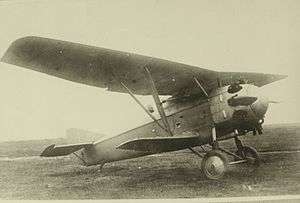Tupolev I-4
| Tupolev I-4 | |
|---|---|
 | |
| Role | Fighter |
| National origin | Soviet Union |
| Manufacturer | Tupolev |
| Designer | Pavel Sukhoi |
| First flight | 1927 |
| Retired | 1933 |
| Primary user | Soviet Air Force |
| Number built | 369 |
|
| |
The Tupolev I-4 was a Soviet sesquiplane single-seat fighter. As his first aircraft design, it was conceived in 1927 by Pavel Sukhoi for Tupolev as the first Soviet all-metal fighter.
Design and development
After the first prototype (under the development name Andrei Nikolayevich Tupolev fighter 5 | ANT-5), the I-4 was redesigned with a new engine cowling to decrease drag, added rocket launchers on the upper wing, and a larger tailfin. The lower wing was predominantly an attachment for the wing struts; it was (almost) removed in the second series, the I-4Z (where the lower wings were greatly shortened) and totally removed in the I-4bis, thus transforming the aircraft from a sesquiplane into a parasol-wing monoplane.
Operational history
The I-4 was used as a parasite fighter in experiments with the TB-3 bomber. The aircraft was in Soviet service from 1928–1933. A total of 369 were built.
Variants
- ANT-5 : Prototype.
- I-4 : Single-seat fighter aircraft.
- I-4Z : Single-seat fighter with span of lower wings greatly reduced.
- I-4bis : Monoplane version (lower wings totally removed).
- I-4P : Floatplane version.
Operators
Specifications (I-4)
General characteristics
- Crew: one, pilot
- Length: 7.27 m (23 ft 10 in)
- Wingspan: 11.42 m (37 ft 5 in)
- Height: 2.82 m (9 ft 2 in)
- Wing area: 23.8 m² (256 ft²)
- Empty weight: 978 kg (2,156 lb)
- Loaded weight: 1,430 kg (3,153 lb)
- Powerplant: 1 × M-22 (Bristol Jupiter) piston radial, 343 kW (460 hp)
Performance
- Maximum speed: 257 km/h (160 mph)
- Range: 840 km (524 mi)
- Service ceiling: 7,655 m (25,100 ft)
- Rate of climb: 555 m/min (1,820 ft/min)
- Wing loading: 60 kg/m² (12 lb/ft²)
- Power/mass: 0.25 kW/kg (0.15 hp/lb)
Armament
- 2 × 7.62 mm machine guns
See also
- Related lists
External links
| Wikimedia Commons has media related to Tupolev I-4. |
The initial version of this article was based on material from aviation.ru. It has been released under the GFDL by the copyright holder.